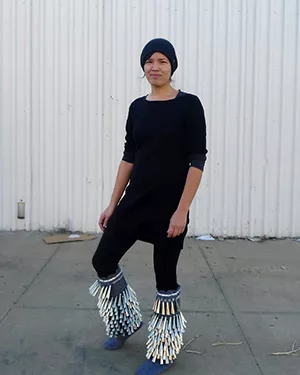
Here She Lands
“I was having a flashback to my first year here at UTM when people in my class asked me why I was smiling all the time,” says Professor Maria Hupfield, reflecting on her years spent as a student in the Art and Art History program at UTM back in the late 1990s.
“It was just such a dramatic change from living in the bush up by Parry Sound. I couldn’t believe how fortunate I was to be someplace where I could study art and do what I wanted to do.”
Cut to 2019: Hupfield returns to campus as an Assistant Professor cross appointed to UTM’s Departments of Visual Studies and English & Drama and as the first Canada Research Chair (CRC) in Transdisciplinary Indigenous Arts. Along with a number of academic appointments now under her belt, she is also a globally renowned multidisciplinary Indigenous artist.
Though she has been making things from a young age as part of her Anishinaabe Ojibwe culture, and comes from a creative family of artistic parents, aunts, and siblings, Hupfield says that her nearly decade-long stint based in Brooklyn, New York, making her mark in art circles there just prior to coming back to UTM, was also spent marvelling at the opportunity to be part of such a thriving arts community. She has collaborated with a number of notable international artists including Charlene Vickers in Vancouver, and in New York with Electric Djinn, IV Castellanos, Esther Neff, and Tusia Dabrowska.
Her recent art installations include her first major solo exhibition, The One Who Keeps on Giving, which toured Canada, the US, and Paris in 2017-18, as well as art collaborations such as All Places All Times Always and Forever (Vancouver), Electric Prop and Hum Freestyle Variations and Here We Land (US), and group-performance pieces in Venice and Zurich.
She has also held faculty appointments at various institutions including a teaching gig at York University, and an appointment as an Assistant Professor at Emily Carr University of Art and Design.
Despite Hupfield’s many artistic and academic accomplishments over the past two decades that same level of enthusiasm and delight still spills over into this new role she is starting at UTM.
“It’s pretty exciting,” says Hupfield in a recent VIEW to the U podcast interview. “I’m just starting out, and I am running, doing all kinds of things, like locating a studio, which we are calling the Indigenous Creation Studio here on [the UTM] campus that will function as a drop-in space and hub where I’ll be operating out of with some work-study students to begin to reach out to all kinds of people.”
The people she is aiming to attract to the makerspace studio are other researchers and scholars from various departments, students, artists, curators, as well as the community, to elicit and encourage participation with various activities, and this is just one of the projects she will be undertaking in conjunction with her CRC designation.
She will also be working to establish a Community Medicine Garden that will serve as both an outdoor event and teaching space, as well as a spot for a sustainable, community based growing environment to study plants and medicinals as a means to explore Indigenous-related curriculum. Lastly, Hupfield will also foster Indigenous knowledge sharing through a Living Archive that will involve UTM students and faculty connecting with local native communities to gather and preserve their stories and histories, lessons and learnings.
Hupfield’s areas of expertise include performance practice that references Anishinaabeg oral history and feminist-performance history, Native Feminisms, and she works in a variety of media including sculpture, video and performance. Her innovative industrial-felt creations have held a place of prominence in her past exhibitions and include items such as signature tin-jingle boots, a jingle-spiral covering, a cassette recorder with headphones, and a snowmobile helmet.
“Felt straddles a space where it’s the felt that we think of around craft and then also high art because of this history with modernism,” says Hupfield, in reference to the work of artists like Joseph Beuys.
Hupfield also co-founded Native Art Department International with her husband, artist Jason Lujan, who is Chiricahua Apache and Mexican. As a duo they curate group exhibitions and also collaborate to give voice to Indigenous stories at home and abroad.
“Jason had an instructor who is an elder who said that no matter where in the world you are, if you’re Native, there’s someone speaking on your behalf,” says Hupfield.
“There is a need to take control and think about who’s writing those narratives,” she says. “If people aren’t aware of your knowledge or expertise or your cultural background, whatever it is, then you are afforded the opportunity to connect through the medium, through the material, through the aesthetic that then becomes their point of contact.”
Resources
For more on Maria Hupfield’s work, visit her website: https://mariahupfield.wordpress.com/
See artist profile video by Dylan Mclaughlin for the Native Art Now exhibition of contemporary Indigenous art featured at the Nordamerika Native Museum (Zurich, Switerland): https://vimeo.com/113761812
See a short snippet of part of Hupfield’s installation, The One Who Keeps on Giving: https://www.youtube.com/watch?v=YN__rxBqOGc
